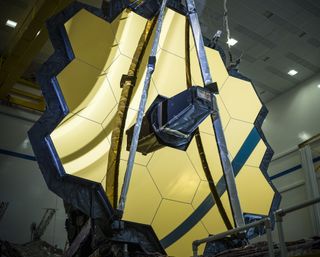NASA unveils list of 1st targets for James Webb Space Telescope
These first targets offer a sneak peek at Webb's capabilities.
Our first glimpse through the eyes of NASA's massive new observatory will include nebulas and an alien world.
Although the long-awaited images won't be available until a live broadcast on Tuesday (July 12) at 10:30 a.m. EDT (1430 GMT), NASA has released a list of the targets that will appear in the first science-quality images released from the next-generation James Webb Space Telescope. Agency leaders have promised that these images will reveal an unprecedented look into some of the deepest views yet of the cosmos.
The targets, which NASA announced on Friday (July 8), were selected by an international committee of scientists from NASA, the European Space Agency (ESA), the Canadian Space Agency (CSA) and the Space Telescope Science Institute in Maryland, which manages the observatory.
Live updates: NASA's James Webb Space Telescope mission
Related: How the James Webb Space Telescope works in pictures

The James Webb Space Telescope's first targets include:
- The Carina Nebula: One of the brightest nebulas — clouds of gas and dust — in the sky is about 7,600 light-years away from Earth in the southern constellation Carina, the Keel. The Carina Nebula is home to the well-known "Pillars of Destruction," long finger-like structures of cosmic gas and dust.
- WASP-96 b: A giant and extremely hot exoplanet and the first known planet with an entirely cloudless atmosphere, WASP-96 b is also the first planet scientists have spotted with such a profoundly strong sodium signature. The planet's mass is quite similar to Saturn's, leading researchers to classify the world as a "hot Saturn."
- Southern Ring Nebula: The Southern Ring or "Eight Burst" nebula, located some 2,000 light-years from Earth, surrounds a dying star.
- Stephan's Quintet: This compact galaxy group is located in the constellation Pegasus and consists of five galaxies, four of which are closely grouped and expected to merge with one another.
- SMACS J0723.3-7327: The James Webb Space Telescope will use the phenomenon known as gravitational lensing, in which much nearer foreground galaxies magnify and 'bend' light to obtain a deep-field view of extremely distant and faint galaxies.

The observatory recently completed calibration and testing on the third of its four scientific instruments, the Near-Infrared Spectrograph, or NIRSpec. Webb's other instruments include:
- The Near Infrared Camera (NIRCAM), the telescope's primary tool for detecting light from early stars and galaxies. The camera features a coronograph, a tool that can block out the light emanating from stars in order to see the bodies around it.
- The Mid-Infrared Instrument (MIRI), a combination of a camera and a spectrograph that examines the mid-infrared part of the electromagnetic spectrum.
- The Fine Guidance Sensor/Near Infrared Imager and Slitless Spectrograph (FGS/NIRISS), a tool that can help detect distant, early light sources and identify and analyze exoplanets.
Between these four instruments, Webb can perform observations in 17 different modes.
Get the Space.com Newsletter
Breaking space news, the latest updates on rocket launches, skywatching events and more!
NASA released a late-stage test image from the Fine Guidance Sensor on Wednesday (July 6) to give a sense of what to expect in the coming images.
Stay up-to-the-minute on Tuesday with our James Webb Space Telescope live updates.
Email Brett at BTingley@Space.com or follow Brett on Twitter at @bretttingley. Follow us on Twitter @Spacedotcom or on Facebook.
Join our Space Forums to keep talking space on the latest missions, night sky and more! And if you have a news tip, correction or comment, let us know at: community@space.com.

Brett is curious about emerging aerospace technologies, alternative launch concepts, military space developments and uncrewed aircraft systems. Brett's work has appeared on Scientific American, The War Zone, Popular Science, the History Channel, Science Discovery and more. Brett has English degrees from Clemson University and the University of North Carolina at Charlotte. In his free time, Brett enjoys skywatching throughout the dark skies of the Appalachian mountains.
Most Popular


